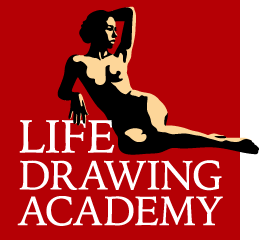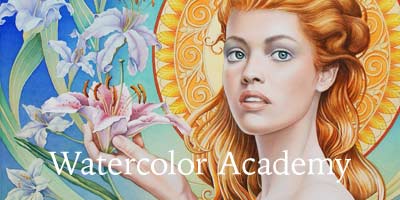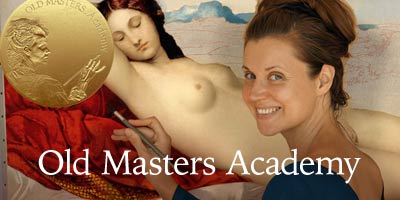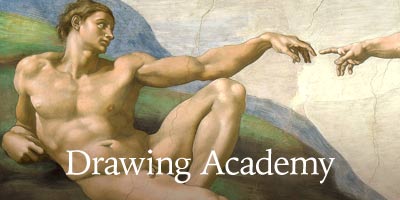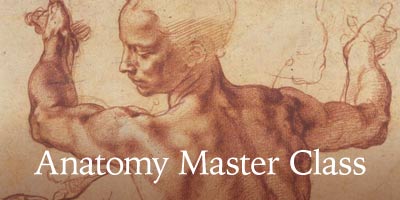Video by Vladimir London
Enroll in the Life Drawing Academy now!
Huion KeyDial Mini - Portrait Drawing
Video by Vladimir London, a Life Drawing Academy tutor
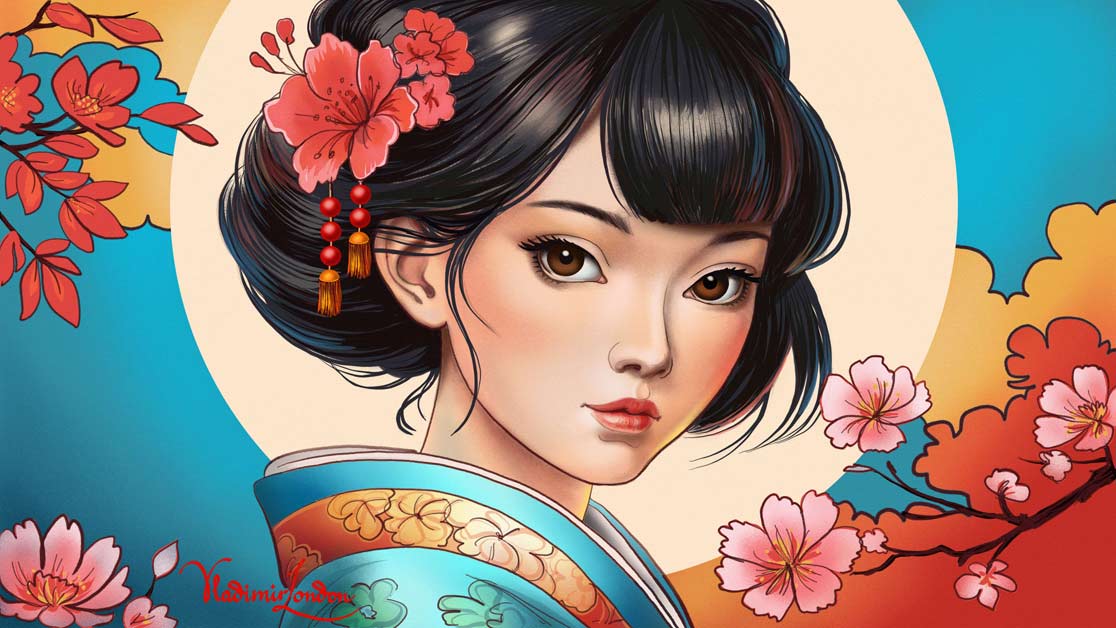
In this video, you will see how Huion Keydial Mini can help in digital drawing. You will see the complete process of making this manga portrait. As a Life Drawing Academy tutor, I teach students from all over the World professional drawing skills. If you are a digital artist, illustrator or designer, you need good tools. In the previous video, I made this manga artwork on Huion Kamvas Pro 24 (4K) pen display. It is a great 24-inch display that supports over one billion colors and covers one hundred and forty percent of sRGB gamut.
This digital pen-display comes with the Keydial Mini device, which can greatly help in your workflow. This device is also available to purchase separately from the Huion website.
Huion Official store Huion Amazon store (US) Huion Amazon store (UK)
It comes in a nice box. The model number is K20. The device is placed in a plastic pouch. It is compact, well-built, and feels solid. At the top, there is a USB-C port, and on its side, the power button. A sleek dial is at the top, and below, there are 18 programmable buttons. The box also contains a Quick Start Guide with easy to follow instructions. There are two self-adhesive sets of button labels. The cable has USB-C and USB-A connectors. The L-shaped connector plugs into the device and another end can be connected to your computer or pen-display. I will plug this Keydial Mini into a laptop to fully charge it. You can notice that the LED lit logo is now on. Before using this device, you need to install a driver, which is available from the Huion website. The installation process is easy and straight-forward. When the device is fully charged, you can unplug it. It can be connected to a computer wirelessly. To pair, simply switch the device on and press the top four buttons simultaneously. Next time you switch this device on, it will connect to your computer automatically.
The driver interface is easy to understand. Just select the Keydial Mini option to adjust its settings. The Brightness of the LED is changeable, from zero to five. The Dial Setting should be On if you plan to use it. You can also adjust the dial's sensitivity. The sleep time will influence the battery use. You can also restore defaults at any time. In the corner, there are battery and Bluetooth indicators. The default settings are programmed for generic use, but you can change those settings to whatever you want. To do such a setup, add a program you want to use. I will draw in Rebelle 6, so it has to be on. The dial has three functions, but I only need one - zooming in and out. To switch between functions, you need to press the round button on the dial.
Now, let's talk through the buttons. The top-left is for displaying the settings. I will keep it as is. This button is for 100% view. The shortcut is zero. After zooming in and out, it will be easy to switch to actual size by pressing this button. I assigned the top-right button to fit the drawing area to the screen. To change settings, simply click on a button and select whatever you want it to do. In this case, I want a keyboard key shortcut. The keystroke is entered by pressing the corresponding keys on your computer keyboard. Also, you can give a name for that action. Here, I typed "Zoom 100%". The shortcut for the "Fit to screen" action is different; it is Command-zero. By the way, if you are not using shortcuts, you should. It greatly speeds up the workflow. For example, to see all the shortcuts for the Rebelle drawing program, go to "Rebelle", "Preferences". In the "Keyboard" tab, you will find all the shortcuts for different uses. Such shortcuts may consist of one, two or three keys. Just check out all the options and make a note of those key-combinations that you may use most often when using a program. I'm sure you already use many shortcuts, but the challenge is that when you draw on a pen-display, a keyboard might be placed at some distance, so replacing it with a Keydial Mini is a good solution. Another useful shortcut is "Undo". I'm sure you use it often in almost every program. So, setting it up for Rebelle makes sense. If you use "Undo", the next one you need is "Redo". It is used less frequently, so a smaller button next to the previous one is a good choice. I program the "Enter" button as "Save". One of the mistakes digital artists make is not saving files often enough and sometimes losing unsaved changes. The next three pairs of buttons will be dedicated to adjusting colors. This button will increase Hue. I will name it accordingly. The button below will decrease Hue. Its shortcut consists of three keys. The next pair of buttons will change Saturation. The top button will increase saturation. I will give it a corresponding name. The bottom button decreases saturation. And two more buttons will adjust tonal values of colors. The top button will make the color lighter. While the button underneath will darken it. There are also two important keys I want to assign to the Keydial Mini. The Shift button, and the Command button. On Windows OS, this would be the "Control" key. And finally, the "Brush Reset" function will be next to the Command button. This would do for now. Of course, you can restore defaults at any time. When you are happy with new settings, it is better to backup them. Just export the set, so it could be used later should you reset your settings or use this mini device with another computer. There are several more options to choose from, including the interface color, language, etc.
Now, I will show you those settings in action. Currently, the drawing area fits the screen. By turning the dial, I can zoom in and out with ease. Also, with the push of a button, I can change the view to 100%, or make it fit the screen by pressing another button. It's really handy when you draw on a pen-display. Next two useful buttons are undo and redo. The "Save" button provides another important functionality. Let's see how this device can help to adjust brushes. In Rebelle, when pressing the Command key, the brush size can be changed by moving the stylus sideways. When moving the pen up and down, opacity changes. You can do it by moving sliders on the Brush Panel, but doing it with the device makes it more natural. Also, I can reset the brush settings with a push of a button. Here it is. A big size goes back to default when I press that button. The Shift button gives extra functionality. Here, I draw straight lines, for example. It is very easy to undo those lines; so is redoing them. Now, let's play with colors. These two buttons will adjust Hue. Instead of clicking on the color wheel to pick some hue, I can simply press the button to go at equal increments, slightly changing the color with each click. OIn the color circle, I can move the pointer clockwise or anticlockwise. It might not seem like a very useful function because selecting some color with a pen is easy enough, but here it is in action. Each brushstroke has a slightly different hue and the difference in hue is equal at every step. I do it at least three times faster with this device, should those hues be selected manually on the wheel. Of course, the same functionality can be achieved with keyboard shortcuts, but here I'm pressing a single button and the mini device is at hand, unlike the keyboard, which I need to reach on the laptop. In a way, the Keydial Mini is a miniature programmable keyboard with 18 buttons and the dial. It can be programmed for different programs separately, so the functions would satisfy most if not all your shortcuts needs. The next important color setting I set up is saturation. Any given hue can be saturated or desaturated. Let's see this functionality in action. I picked red, and now make each brushstroke lighter than the previous one. Every tint of red is lighter at some constant increment from full color to white. Now, let's see how it works in another direction: from desaturated grey to fully saturated red. Pressing the button to increase saturation makes each brushstroke more colorful. This gradient has the same hue - red, but each stroke has different saturation. The third important quality of color is its tonal value. Every color can have lighter tints or darker shades. I will make one more gradient to demonstrate it. Here's the fully saturated brightly-violet color. With every push of a button, I decrease its tonal value at a small step. The gradient becomes darker and darker until it reaches totally desaturated black.
Now, I have to say a few words about color theory. The widest spread of chroma, which is another word for hue or color, is from pure color to neutral gray. Such a gradient is called the chroma range. The value range changes from light to dark tones and the widest value range is from white to black. By mixing some pure color with white, we obtain tints. And by mixing such a color with black, we get shades. So each hue can have tones, which is the degree of mixing it with neutral gray, as well as light tints and dark shades. These chroma and value ranges are well-presented on this diagram from one lesson on color theory from the Watercolor Academy course. This academy covers color theory in depth and what I explained here is a very small bit from that theory. If you want to learn more and develop good painting skills, check out Watercolor Academy by watching its free video tutorials.
Now, I will show you how to make this manga artwork on Huion Kamvas Pro 24 (4K) display with the help of a Keydial Mini device. I will begin with the face construction. A very important virtual helping line is the vertical symmetry axis. Perpendicular to this line, in the middle of a head, goes the level of eyes. Two more important landmarks are the levels of eyebrows and the base of a nose. These levels split the face height into three almost equal parts. The facial part and the cranium are the main volumes of a head. Other virtual lines will help to place facial features correctly. Check out my book to learn how to draw a portrait in the three-quarters view, which is available on Amazon. With helping lines of construction in place, it is easier to draw facial features and head outlines. Sketching such construction is optional. A proficient artist may keep it in mind. After you make more than five thousand portrait sketches, the canons of proportions will become embedded into your mind, so you could draw portraits on autopilot without references or models. Here's another tip. If you are interested in making manga artworks, you still need to learn constructive drawing principles, perspective, anatomy for artists and canons of proportions. The manga style is not the way to escape proper drawing skills, but a stylized approach to drawing. A classical Greek or Roman canon of head proportions is easy to turn into manga when you know the rules. For example, in this sketch, I intentionally amended the classical canon of proportions, making the lower third of a face smaller, eyes bigger, the chin more pointed, the nose less straight, and so on, to get a stylized manga portrait. This face still follows the rules of anatomy and construction; it has the correct perspective and foreshortening. It is an illustration, not a hyperrealistic drawing, which is exactly the creative task I have in mind. If you feel that your portrait drawing skills need to be improved, there is one course you can take online to learn all you need to know about figure and portrait drawing - Life Drawing Academy.
This artwork is progressing nicely. I'm applying the shortcut by pressing a dedicated button on the Keydial Mini to adjust brush size and opacity. With such a device under your hand, it is very easy to get used to it. Of course, it cannot replace the full keyboard, but its purpose is different. All I need from this little gadget is a selection of the most used key-combinations for each program I use when drawing on the pen-display. Of course, every artist is different, and personal habits may vary. For example, some artists might prefer rotating the canvas when drawing. This functionality is easy to set up on the Keydial Mini. The dial can rotate a drawing area clockwise and anticlockwise. I keep it horizontal at all times. The girl's face is complete. I will now render the hairstyle. For this manga artwork, I use bright colors, but keep the color palette rather limited. In a way, there are only three main colors - red, blue and yellow. They are called primary colors. In this artwork, only red is close to pure red. The yellows and blues are shifted slightly to orange and green respectively. This calms down a highly saturated palette of colors and makes it a bit more settled. Digital drawing is just a medium. It requires good skills no matter what you use - a pen and paper or a stylus and screen. I hope you've found this video interesting and my tips for a Keydial Mini helpful.
To learn good drawing techniques, enroll in the Life Drawing Academy course:
Online Course
A self-study, self-paced course for you to learn fundamental methods of classical drawing and improve life drawing skills by watching video lessons and doing assignments
- Unlimited access to 52 life drawing video lessons
- Lifetime membership without deadlines
- Unlimited support from the Academy tutors
- Constructive critique of your artworks
- Member access to the Academy's Art community
- Place in the Academy's Students Gallery
- Exclusive members-only newsletter and bonuses
- Life Drawing Academy Diploma of Excellence in your name
One-time payment - Lifetime membership
$297 USD
Personal Tutoring Online + Online Course
The ultimate choice if you who would like to receive personal, one-to-one tutoring from the Academy teachers, which is custom-tailored to your skills and needs
- Everything in Online Course, plus:
- Dedicated team of art tutors
- Assessment of your current level of drawing skills
- Personalized curriculum tailored to your skills and goals
- Up to 100 drawing tasks with by-task assessment
- Unlimited one-to-one personal coaching with detailed per-task instructions and feedback
- Artwork critiques and results-oriented guidance
One-time payment - Lifetime membership
$997 USD
